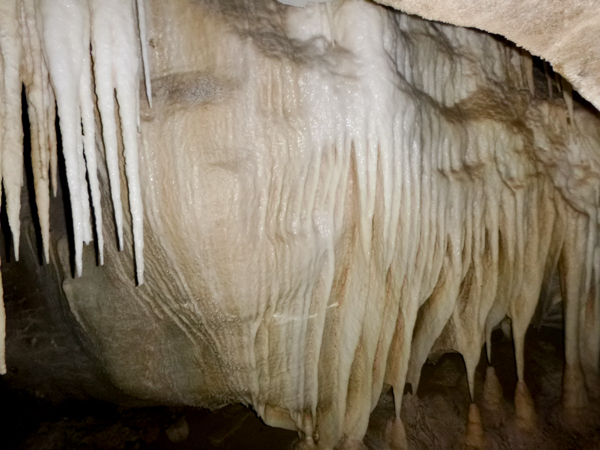
by Editor | Apr 1, 2019 | Attractions, Luxury Travel
By Elena del Valle
Photos courtesy of Underworld Adventures*
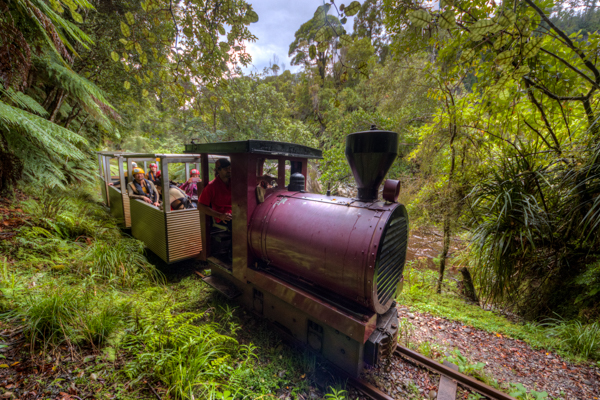
We rode a small train for two kilometers to reach the Metro Cave in the Paparoa National Park in the South Island, New Zealand.
I had been looking forward with a bit of trepidation to Underworld Rafting, a hiking, glowworm viewing and river rafting experience in the Metro Cave Te Ananui Cave of the South Island of New Zealand since Veronika Vermeulen, owner of Aroha New Zealand Tours Ltd. (539C Key Road, RD1, Kinleith, Tokoroa 3491, New Zealand, +64-21-890 611, https://www.arohatours.co.nz/, info@arohatours.co.nz) and my guide in New Zealand, recommended it for inclusion in my custom itinerary. She said if I was open to new experiences and able to hike a short distance in the heat of summer I would like it. I trusted her judgement and agreed to go. When the day arrived I applied liberal amounts of insect repellent to protect me from the New Zealand sandflies as well as sunblock and set aside any concerns. I was glad I did because it was outstanding.
From start to finish the four hour soft adventure within the 430 square kilometer Paparoa National Park in the West Coast was far more fun (and at times more challenging) than I had expected. Following a short drive from Birds Ferry Lodge and Ferry Mans Cottage, where I was staying near Westport, Veronika and I arrived at Underworld Adventures (State Highway 6, Charleston 7892, West Coast, South Island, New Zealand, +64 3 7888 168, www.caverafting.com, contact@caverafting.com) in the late morning.
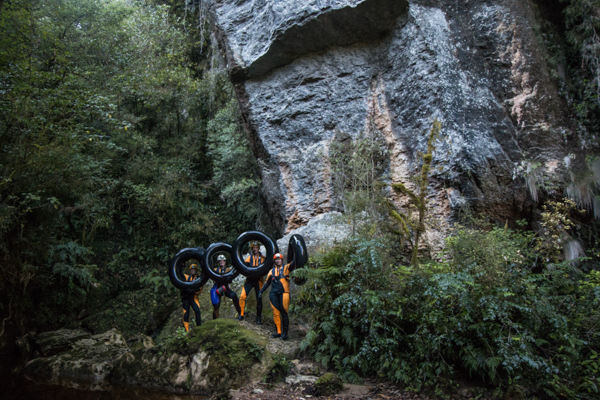
Wearing wet suits we hiked 131 steps to the cave entrance carrying a tube like the ones in the photo.
Mira Schwill, co-manager with Ray Moroney, greeted Veronika warmly. Following introductions we sat at a table in the Underworld Adventures and Café, a sunlit space with a towering ceiling that was the home of Underworld Adventures, to complete our sign-in on a digital tablet. Minutes later we descended to the lower level of the building, where we changed into wet suits and met Peter, our guide. The staff handed each of us a helmet with a light. Although Veronika and I were on private tour with Peter we had to make our way to the cave and back with a tour group. We saw them in the changing area, but they spoke no English and kept their distance when we greeted them. While we waited for the tour group to join us Peter, an energetic and enthusiastic young man who liked to surf as a hobby, outlined our activities and easily answered all my questions.
Once everyone was ready we climbed aboard a weathered van with a small European family. The tour group went on a second van. Ten minutes later most of us boarded a small train with two engines, one gas and another diesel. I later learned the engines, called Dorothy and Cecil, had been built for the company in 2002.
We covered two kilometers with the train. Its leisurely pace allowed me to admire the rain forest vegetation along our path. From the platform we walked about one kilometer along a well marked uneven path to the cave entrance. On the way we picked up large tubes, which while lightweight (they weighed between two and a half and three kilos) were awkward to balance while walking on the slippery ground. This was especially true in the steep last section of 131 steps to the cave entrance and inside.

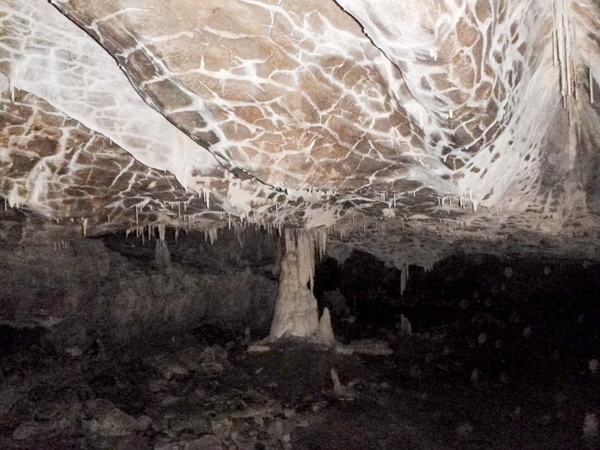
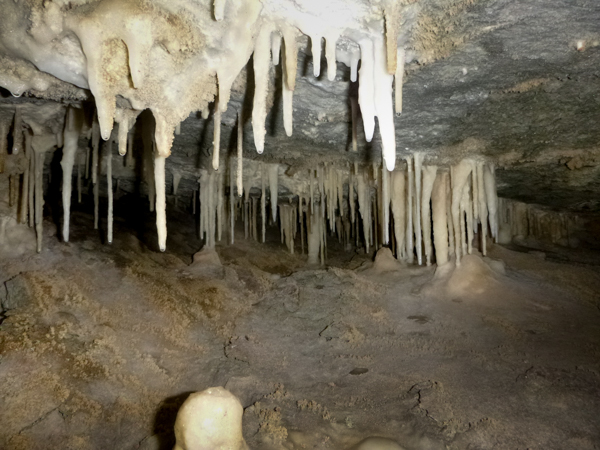
Some of the thousands of stalactites and stalagmites we saw that day
While it had been too warm to zip our wet suits on the way up during the walk inside the cave we could see our breaths in the light of our helmets. It was the only light within the cave. Although I was glad for protection the helmet provided my head It fit loosely and shifted around constantly. We only walked one and a half kilometers of the nine kilometers of the cave. It was slow going due to the low light, pebble strewn uneven surface of the path, shifting helmet, varying height of the cave ceiling and tubes we carried. More than once we were forced to crouch down, while negotiating our balance with the large tube in tow and the helmet moving to an fro.
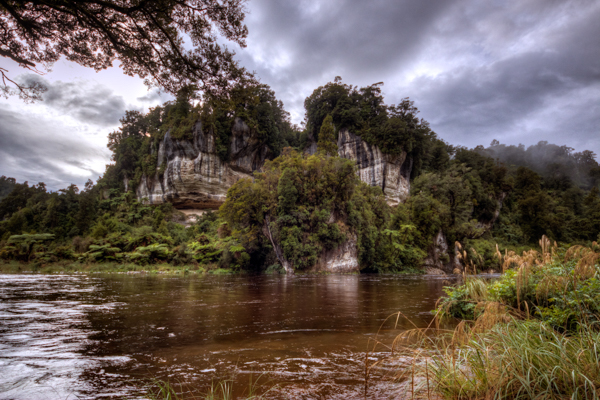
When we exited the cave we floated on our tubes along the Waitakere Nile River.
Inside the cave it was silent and filled in places with thousands of stalactites and stalagmites. There was no sign of the tour group. Peter showed us the cave formations and told us about the man who had discovered the cave. In the serenity of the cave it was as if we were the only ones there like the man who first discovered them carrying matches to break the deep darkness of the unknown within.
Peter watched our slow progress, describing the noteworthy sections of the cave, and offering assistance in particularly tricky segments. After a while I heard the soft sound of moving water. It was almost disappointing because I knew we would soon depart the wondrous world of the cave.
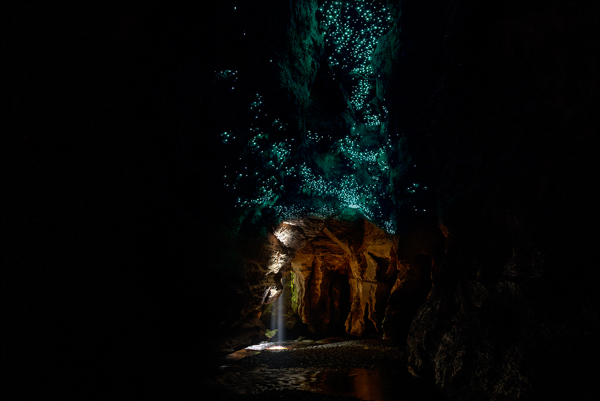
Glowworms in the cave ceiling in the Paparoa National Park in the South Island, New Zealand
But, the glowworms stole the show. We lay atop our tubes, turning off our lights and staring up at the ceiling, which moments earlier had appeared bare. As my eyes adjusted to the dark I began to notice pale worm shapes a few feet above us. When we turned the lights back on I examined the arachnids with interest. From there we walked to the water’s edge and climbed aboard our tubes, making our way past thousands more of the glowing creatures. It was unexpectedly moving.
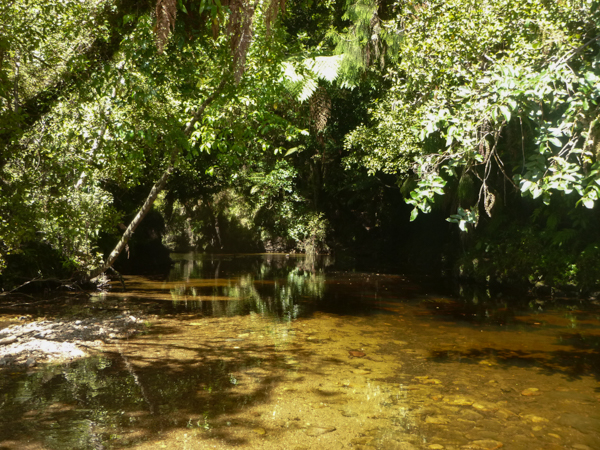
Sun filtered through thick greenery where we floated out of the cave in our tubes.
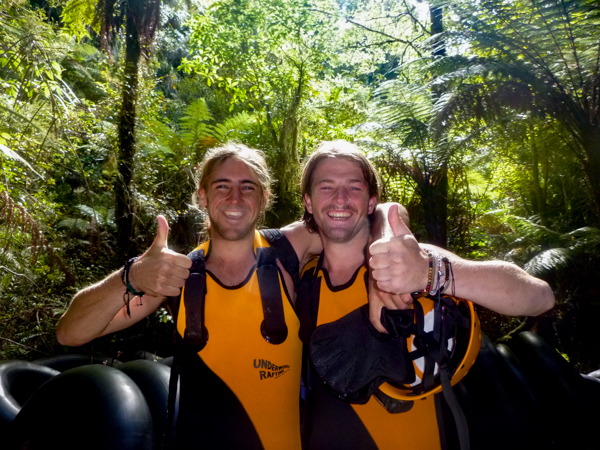
Peter, our guide, and Charlie, who guided the tour group
I was thankful for the wet suit, which kept the chill of the water from cooling me down too fast. The sound of water grew louder and before long we were back in the early afternoon sunshine. The hot sun felt good. I was glad I had sunblock. Around us the river was clean, the water clear as I ran webbed mittens, too large for my hands, in an inefficient yet effortful attempt at steering over the rapids. Peter reminded us to take care as the current carried us one kilometer down the small rapids to our exit point. I was tired and smiling when I walked out with my tube in hand, glad I had followed Veronika’s advice.
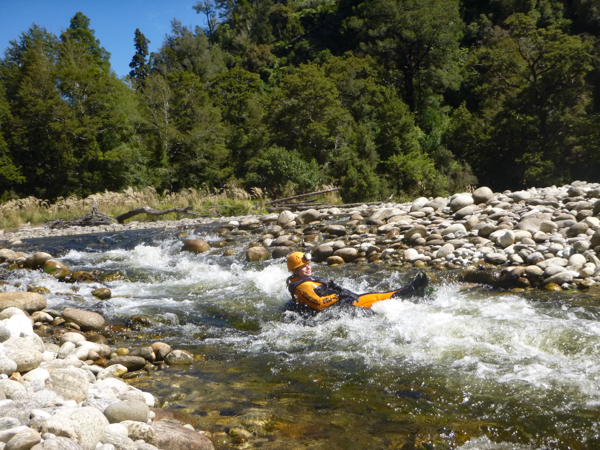 ]
]
Veronika on her way down the small rapids
Our guide had received company training and worked as a guide for three seasons. Underworld Adventures, established in 1987, was owned by Geoff Schurr, Ray Moroney, Stue Berendt, and Graham Howard. It employed nine staff during the off season and fourteen during the high season.
I would recommend Underworld Rafting to my friends who are steady on their feet (there were numerous places were it would have been easy to twist an ankle or loose my footing) while carrying a three kilo tube and a helmet on their heads and in good health. Emergency aid inside the cave could take one to two hours to arrive. Having shared space with a stand offish group during part of the tour I particularly appreciated that mine had been a private tour.
At the conclusion of the tour Underworld Adventures made the photos from that day available for download free of charge. They also provided me with two small printed souvenir photos in an Underworld Rafting sleeve.
*Because I wore a wet suit and didn’t have a waterproof camera I left my camera at the cottage. Additionally, an uneven path and low light conditions in the cave meant special equipment and extra time were necessary for publication worthy photos. Our guide took photos with company equipment during our adventure. The folks at Underworld Adventures kindly allowed us to publish them here along with other photos taken on other dates.
by Editor | Feb 18, 2019 | Attractions, Luxury Travel
By Elena del Valle
Photos by Gary Cox
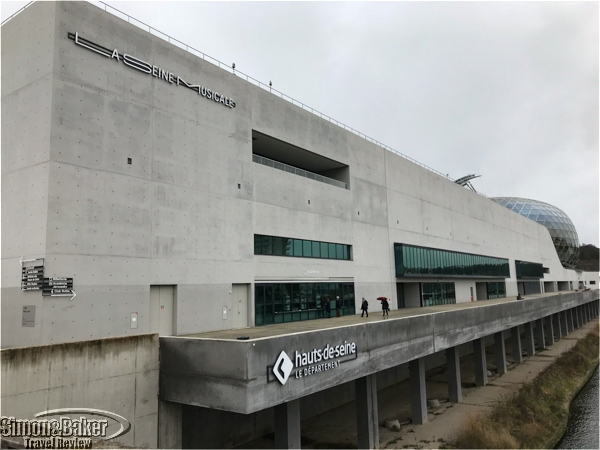
La Seine Musical
On our most recent trip to Paris, France we discovered La Seine Musicale (Ile Seguin, 92 Boulogne-Billancourt, France, www.laseinemusicale.com, + 33 1 74 34 53 53), an events venue opened in 2017 on the outskirts of the city.
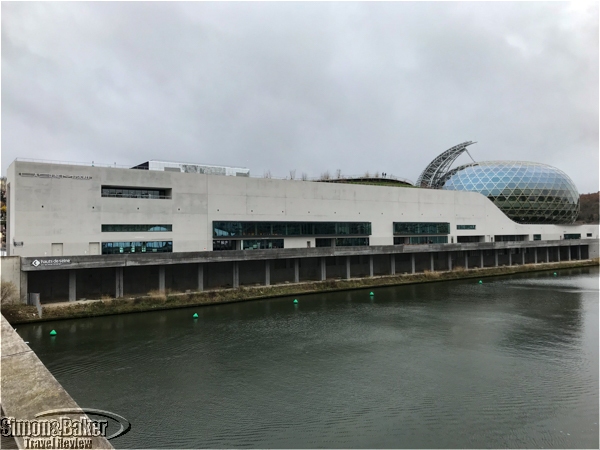
The venue is on an island in the center of the Seine River just outside Paris.
The building, situated on the Seguin Island, has a distinctive architectural design. Inside natural lit filtered past wood and glass walls, drawing us our gaze across the river. The high ceiling gave the building a sense of space.
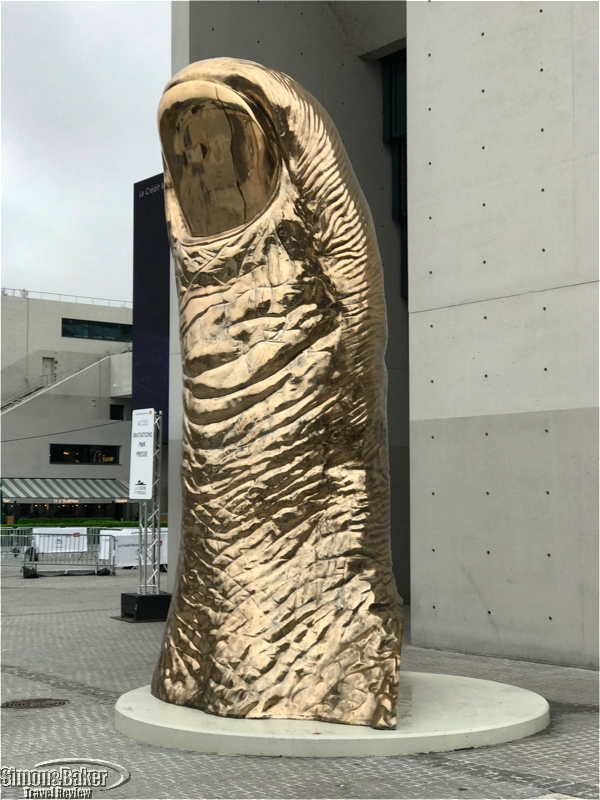
There was a huge sculpture of a thumb in front of the building.
We attended a one hour and fifty minute guitar performance by Liat Cohen accompanied by tenors Rolando Villazon and Charles Castronovo, soprano Sandrine Piau and the Orchestre Pasdeloup. They performed works by Joaquin Rodrigo, Enrique Granados, Jules Massenet, Gabriel Faure, Francisco Tarrega, Isaa Albeniz, Manuel de Falla, Fernando Sor, Tomas Barreras, Rafael Calleja and Tomas Breton. They were fresh from recording Paris-Madrid, an album, that year. It was available for purchase outside the concert hall. Liat’s guitar playing was excellent, earning her repeated applause. It was my favorite part of the show.
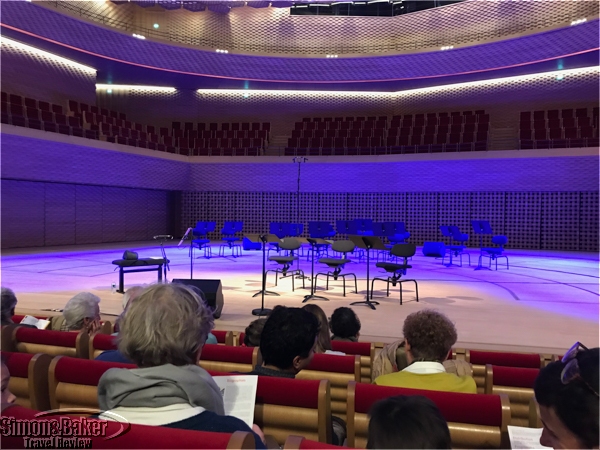
The stage minutes before the start of the performance.
According to her biography Cohen earned First Prize at the Paris Conservatory, graduated from the Schola Cantorum and the École Normale de Musique de Paris; and was the first guitarist to have received the Nadia Boulanger Prize from the Foundation of France.
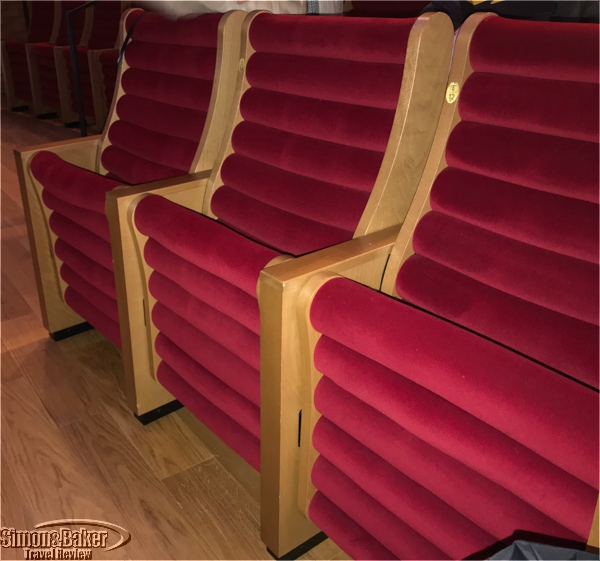
The seats were comfortable and solid.
Our seats (Category 1, E8-10) were comfortable and the view to the stage was unobstructed. Due to photography restrictions we were unable to take photos once the musicians began playing and singing.
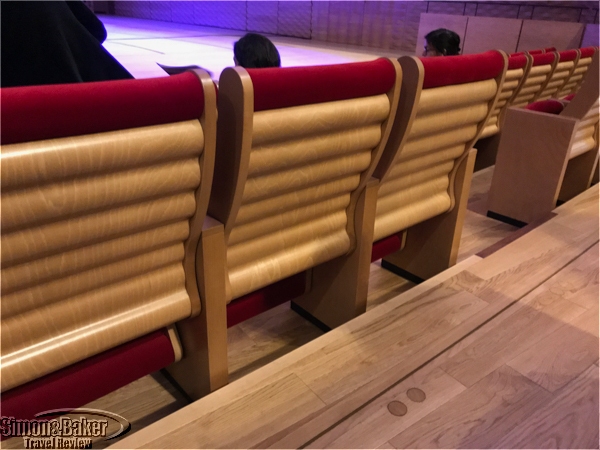
The backs and arms of the seats were blonde wood.
I had read in advance about La Seine Musicale’s rooftop garden, but despite several attempts on arrival and departure it was impossible to visit the garden. Once inside the staff said we couldn’t reach the garden and weren’t allowed to exit and re-enter. At the conclusion of the afternoon show the staff member I spoke with indicated the roof garden was closed.

The walls and ceiling of the theater were covered with a variety of textures and materials.
The theater had two halls with a maximum capacity of 6,000 during 150 shows and an approximate annual attendance of 350,000. The name was derived from the River Seine and the French name for stage, Scène. It was a public private partnership owned by STS Evenements, a joint venture between TF1 and Sodexo.
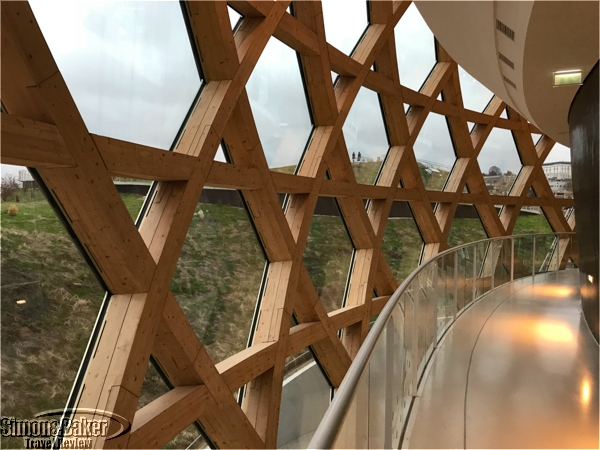
The interior of the dome looking out through solid wood supports
The greatest challenge was that from the Left Bank in central Paris it took us about one hour to reach La Seine Musicale. For a worthwhile performance I would attend a concert there again and recommend it to friends.
by Editor | Jan 22, 2019 | Attractions, Luxury Travel, Products
By Elena del Valle
Photos by Gary Cox and Elena del Valle*
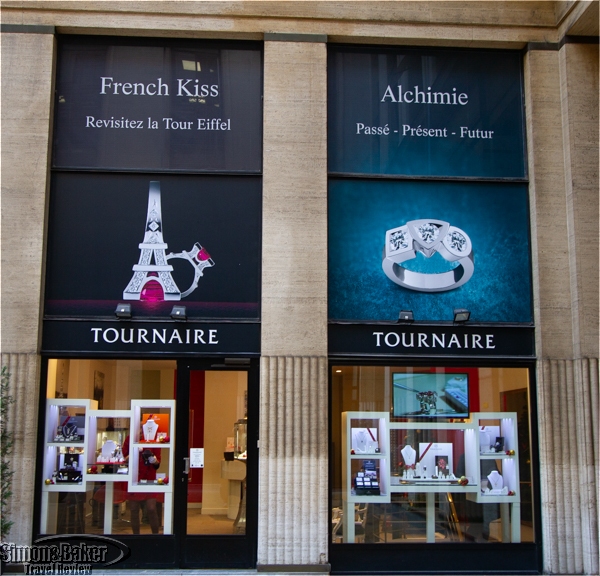
The exterior of the Maison Tournaire shop steps away from the famous place Vendome
It was a chilly and clouded Friday afternoon when I arrived at Maison Tournaire (7 place Vendôme, Paris, France, +33 4 77960884, www.philippetournaire.com, mathieu.pallay@philippetournaire.com), a stone’s throw from the famous Place Vendome in Paris, France for a small group half-day workshop in French. Perhaps because of the well-known venue and crowded streets it was the kind of activity I suspect most tourists never know exists. It had been raining on and off all day. Despite rushing I was five or ten minutes late. As soon as I entered the boutique the staff made me at ease, explaining the workshop had yet to start. While I was still near the door another attendee arrived, distressed at being late. She had been circling the area in search of a parking place for a long while, she explained, making me feel better about my own tardiness.

The meeting room where the workshop took place
The interior of the shop was well lit and populated with jewel filled glass cases. It was elegant without being intimidating, adult yet youthful. Marie, one of the two staff members, put away our wet raincoats and umbrellas, offering us welcome hot beverages in exchange.
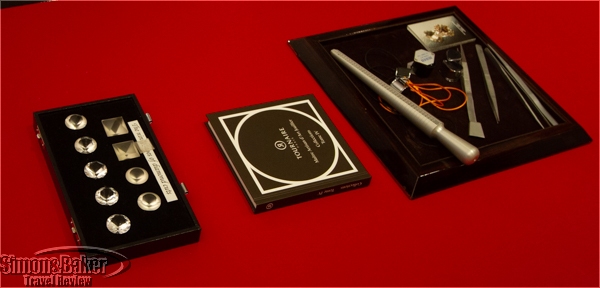
Some of the tools and materials we used during the workshop
After greetings from our host Mathieu Tournaire we climbed one floor upstairs where we sat at a conference table. Mathieu and I had an opportunity to chat earlier that day when he explained everything the company makes is Tournaire-ized. “We don’t just make jewelry, we tell stories,” he told me with a serious expression in between private appointments with clients. The clean shaven jeweler had a quiet confidence that bellied his youthful appearance and the easy manner of a salesman.
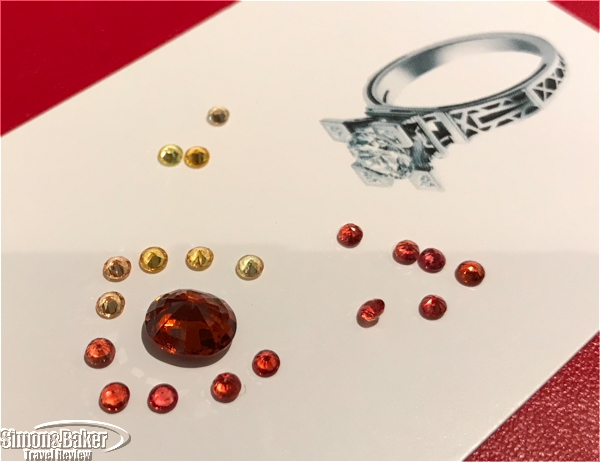
We initially discussed a ring design that could include my yellow and orange sapphires and possibly a large house stone.
Some 15 percent of Tournaire sales were custom orders, he explained. He and his father, Philippe Tournaire, were the creative engines of the firm and both lived outside of Paris. In addition to the Paris location there were stores in Lyon (4 rue Childebert) and Savigneux (2 rue des métiers), where they lived. Whenever he was in town his calendar was full of client appointments.
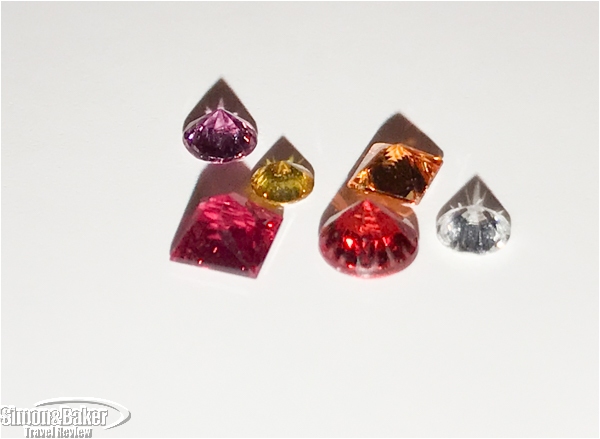
Stones Mathieu selected for the ring
More than half of the attendees had cancelled their workshop reservations because of the soggy weather or the ongoing Yellow Vest demonstrations that riddled France for weeks and peaked on weekends so in lieu of the original nine we were only four. The small group and easy manner of the other attendees made the workshop intimate, allowing each of us to hold tools, rough stones and gemstones in our hands, and observe them with loopes.
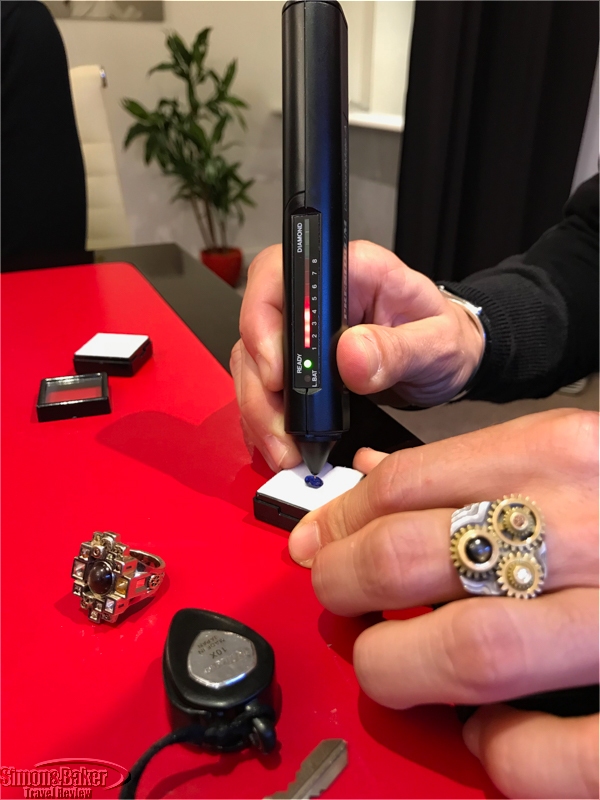
Mathieu demonstrated the use of a device to test diamonds
Mathieu held up a tablet to show us photos, discussing weights, measures, gemstone classifications, varieties and hardness, diamond colors, cuts and facets and demonstrated how to test a diamond with an electronic device. He explained that in France only diamonds, emeralds and sapphires (including rubies) are precious stones. He also discussed opals and star sapphires in passing. Time flew and before I realized it the workshop had ended. At its conclusion we each received a stamped certificate or Certificat de Participation as a souvenir.
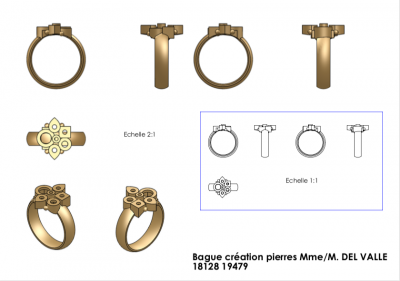
An image of the 3D model for the ring Mathieu designed (*courtesy of Maison Tournaire)
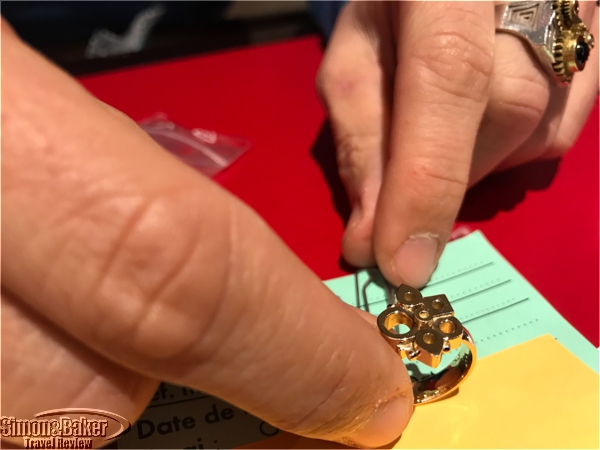
The ring setting Mathieu designed without stones, just the yellow gold part
Once the workshop was over Mathieu spent private time with several of the attendees. Earlier in the day he and I had discussed an idea for a custom made ring. He had drawn a Tournaire-ized concept on a piece of paper and shown me some small gemstones for possible inclusion (diplomatically rejecting my own stones). If all went well, he would share a 3D design via email before making a ring to show me before I left France.
Outside it was dark, but at least the rain had slowed to a drizzle. I didn’t mind the rush hour crowds and wet pavement so much as I walked back to the rue de Rivoli and south toward the Left Bank remembering my fun afternoon.
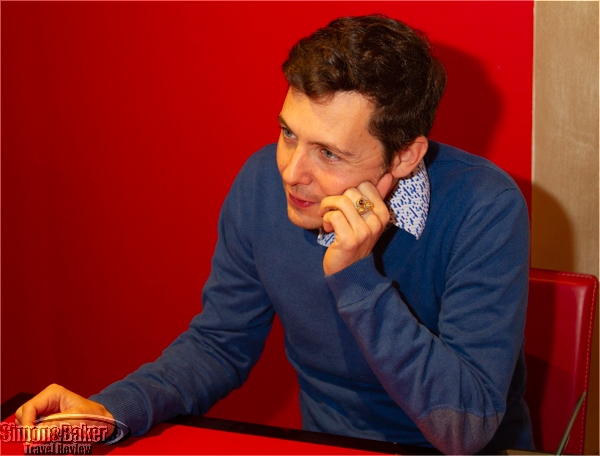
Mathieu Tournaire, artistic director, Maison Tournaire
Maison Tournaire was founded by Philippe Tournaire, a self taught jeweler, in 1973. Mathieu, the artistic director, joined the team in 2008. Maison Tournaire creations were designed to be easily recognized. I had an opportunity to see several of the lines and try on some of the pieces at the shop such as Engrenage (Mathieu wore a distinctive ring of that line), Alchimie, Pensée Sauvage, French Kiss, and Architecture. The ring he created reminded me of the Marélie line, a favorite along with French Kiss.
I liked that Tournaire products were made 100 percent in-house and in France. I appreciated the warm authentic service and efficient follow through. Where attendants at other shops I visited in the place Vendome area were solicitous their welcome was superficial, their demeanor stiff and cool. For example, an eager saleslady on the rue de la Paix offered tax free processing, but could not answer simple questions about the treatment or provenance of her gemstones. Mathieu answered my queries quickly and candidly. One overly inquisitive vendor at a nearby luxury boutique promised to email me information about items they expected to receive, but I never heard from him. In contrast Mathieu and his staff were helpful and responsive without ever being pushy. After the workshop he followed up promptly with the drawing and 3D design we had discussed. Likewise Marie was in touch promptly to schedule a new appointment.

The stones resting on the setting allowed us to see how the finished ring might look.
Two weeks later when Mathieu returned to Paris he brought a 12 by 15 millimeter 18 karat yellow gold ring to show me. It weighed 8 grams and was priced at 3,900 euros. The stones he selected were: 5 millimeter tourmaline rubellite (a red tourmaline), 3 millimeter round red sapphire, 3 square millimeter orange sapphire, two color diamonds of 0.06 carats each, and a white 0.04 diamond. The ring was unfinished, but by placing the gems in their settings it was easy to imagine what it would look like. I especially liked that the diamonds were slightly elevated to protect the other stones. As the hardest stones diamonds would take the brunt of any impact if the wearer banged the ring by accident.
The ring was temptingly pretty. It reminded me of a friend’s redesigned and repurposed wedding ring after her divorce. Every time she looked at it her eyes sparkled with delight. Despite my interest by then my budget had already been fully allocated. Who knows, the next time I am in Paris and have a milestone to celebrate I might pop into Tournaire and say hello. I wouldn’t hesitate to recommend the workshop to friends with an interest in French jewelry wanting an off the beaten track experience in Paris. I would also recommend the shop to those in the market for the brand’s distinctive style.
by Editor | Jan 7, 2019 | Attractions
By Elena del Valle
Photos by Gary Cox, performance photos courtesy Opera National de Paris (OnP)*
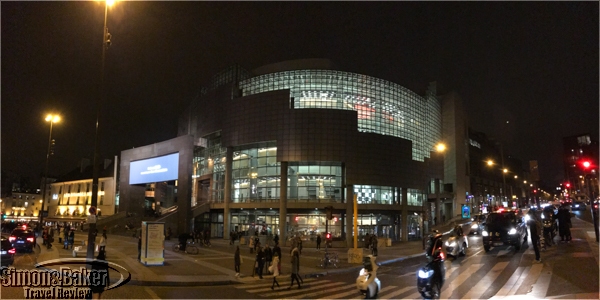
The exterior of the Opera Bastille (click for full size)
In December we attended a most enjoyable sold out performance of La Traviata at the Paris Opera Bastille. The opera by Giuseppe Verdi with the orchestra and chorus of the Opera National de Paris began at 7:30 p.m. and concluded at approximately 10:40 p.m. Ticket prices ranged from 5 euros to 231 euros. Our tickets were in Optima Class in the Parterre section (7A97 and 7A98). In order to have an clear view of the stage I had to switch sweats.

The modern architecture of the Opera Bastille viewed from near the stage (click for full size)
The opera was divided into three acts. The first act lasted 35 minutes followed by a 30 minute intermission. The second part lasted just over one hour and was followed by a 25 minute intermission. The final act lasted 35 minutes.
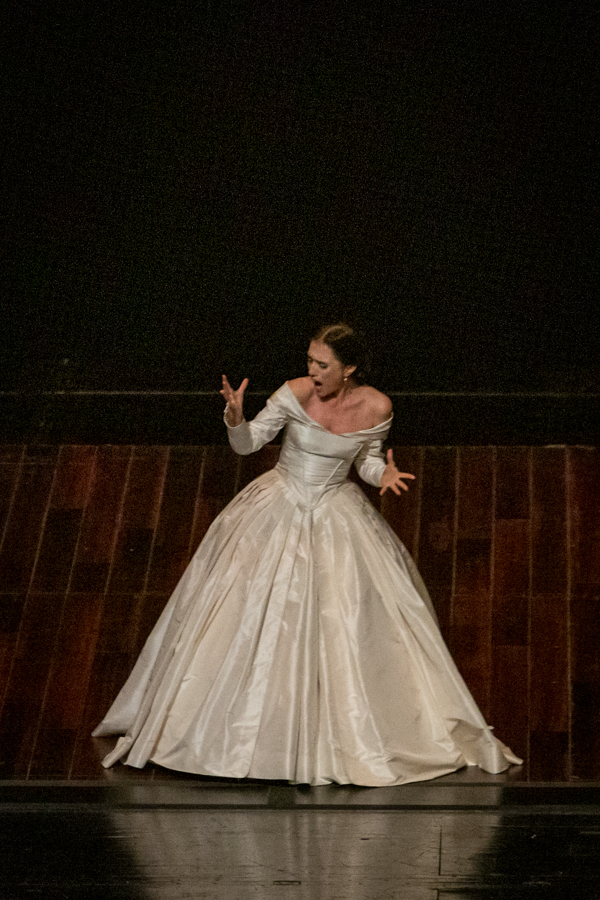
Ermonela Jaho was Violetta – (c) Sébastien Mathé – OnP
While the first act was the biggest crowd pleaser we, and judging by the enthusiastic applause the rest of the attendees, liked the entire opera. There was a gender bending scene that raised some eyebrows. A man seated next to us took exception to the orchestra, booing on multiple occasions.
It was toasty warm inside the theater. The only sour notes were the hard to find box office, where we had to run at the last minute due to processing issues with our credit card, and the pungent urine smell in the ladies room nearest to our seats.
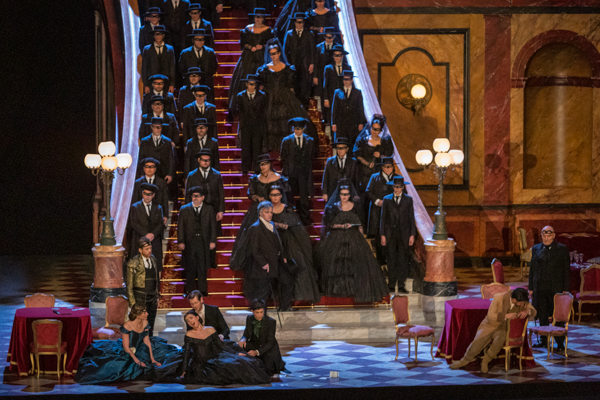
Dramatic staging for a confrontation – (c) Sébastien Mathé – OnP
The program was in French and English. Supra-titles high above the stage and on screens on either side of it provided French and English translations of the original Italian. We could watch the stage or read the supra-titles at any one time. We could only read the text above the stage. After a few minutes our necks tired from holding them at an angle to read the supra-titles at the top.
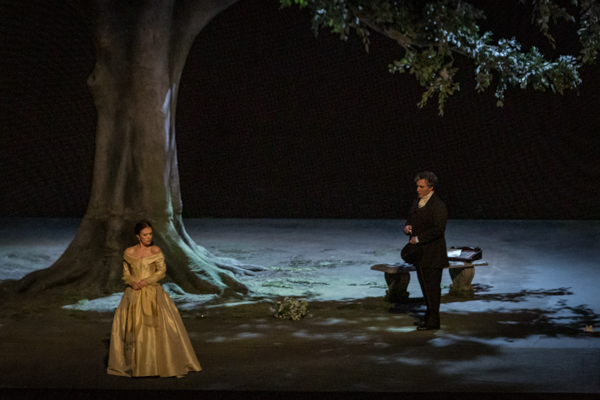
Giorgio asking Violetta to forsake his son. – (c) Sébastien Mathé – OnP
The following contributed to the production: Karel Mark Chichon, conductor; Benoit Jacquot, director; Sylvain Chauvelot, set designer; Chrisian Gasc, costume designer; Andre Diot, in charge of lighting design; Philippe Giraudeau, choreography; and Alessandro Di Stefano, chorus master.
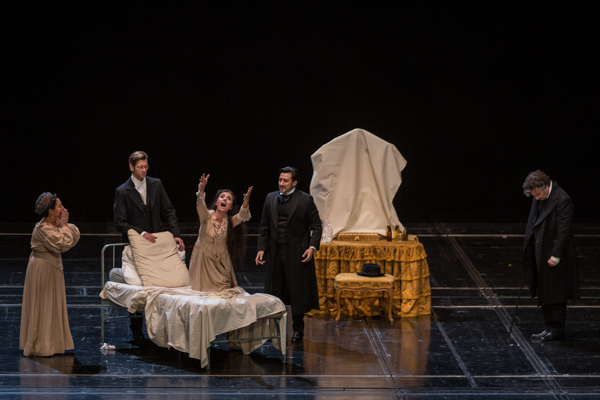
The dramatic final scenes – (c) Sébastien Mathé – OnP
Ermonela Jaho’s Violetta was energetic and moving. Ludovic Tezier enhanced the performance with his powerful Giorgio. At the conclusion the audience clapped for several minutes. It was a superb evening of entertainment and one that will draw me back to the Opera Bastille in the future.
*The Opera National de Paris did not allow photography during the performance. The photos they provided were dated from the Dec 11th, 2018 performance.
by Editor | Nov 5, 2018 | Attractions, Ecotourism
Photos by Gary Cox and Elena del Valle
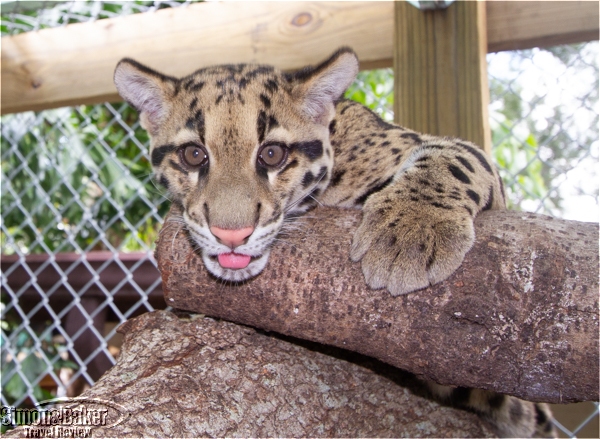
Despite the subtropical heat the sisters were surprisingly relaxed.
We recently spent a few precious minutes inside an enclosure with Lura and Malee, two female clouded leopard (nebulosa) cubs at Panther Ridge Conservation Center (2341 D Rd Loxahatchee Groves, Florida 33470, +1 561-795-8914, www.pantherridge.org) in Florida. A warning about how sharp their teeth were did little to dampen out enthusiasm once we had caught sight of the junior cats through the chain link fence of their enclosure. Lura, seven months old, and Malee, five months old, looked healthy and were full of energy, mock stalking each other and jumping with ease from one side to another. Despite the heat the sisters were surprisingly relaxed, allowing us to watch them and take photos as they played. Their brother was unable to join us because he was recovering from an injury.
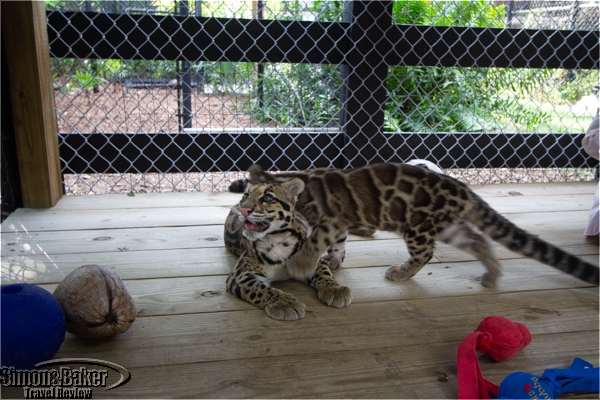
Lura and Malee played while we watched.
Clouded leopards are beautiful and like so many species may be in danger of disappearing in the future. According to CloudedLeopard.org, a Washington State nonprofit (per its website), in 2014 there were only 166 clouded leopards in zoos in the world, including 37 of them in the United States.
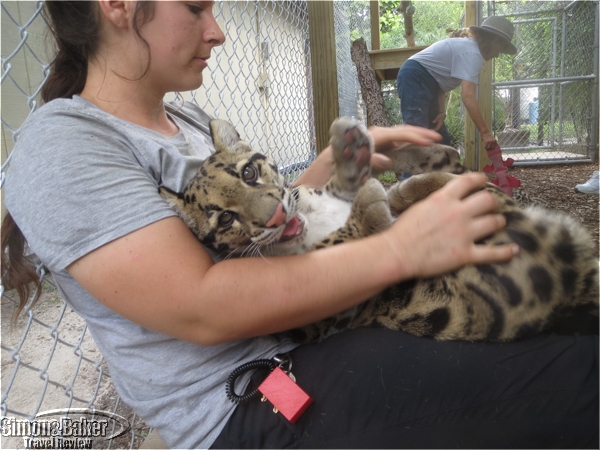
Sadie Ryan, head keeper and facilities manager, holding one of the cubs in her lap
To raise funds for its residents and increase feline awareness Panther Ridge offered tours by appointment and private time with the clouded leopards. Special thanks to Sadie Ryan, head keeper and facilities manager, and Barbie Jetter, assistant director, who welcomed our photographers at their center during an especially busy period. The staff and animals were in the midst of a cumbersome move from Wellington to Loxahatchee in Palm Beach County.
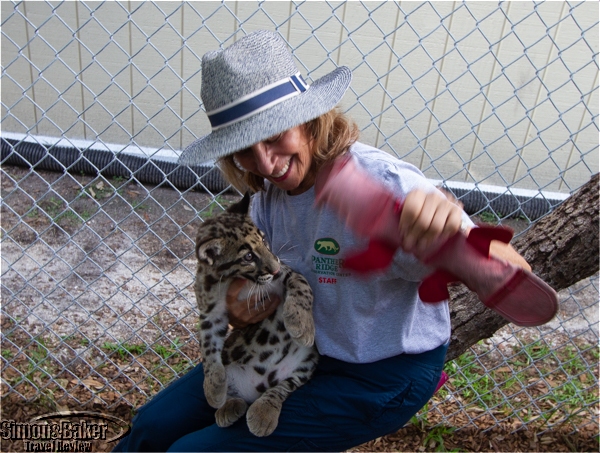
Barbie and one of the cubs
According to the International Union for Conservation of Nature Red List (IUCN), clouded leopards are Vulnerable. The Swiss based membership organization defines the term as “facing a high risk of extinction in the wild.” Although exact numbers seem elusive one website estimated only 10,000 of them remain in the wild.
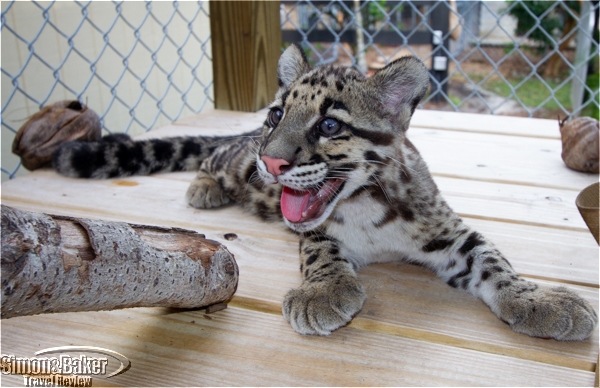
According to the IUCN Red List clouded leopards are Vulnerable.
Panther Ridge is a 501(c)(3) nonprofit dedicated to combining “feline husbandry with conservation awareness to educate the public on wild felines.”
by Editor | Jun 26, 2018 | Attractions, Ecotourism
By Elena del Valle
Photos by Gary Cox*
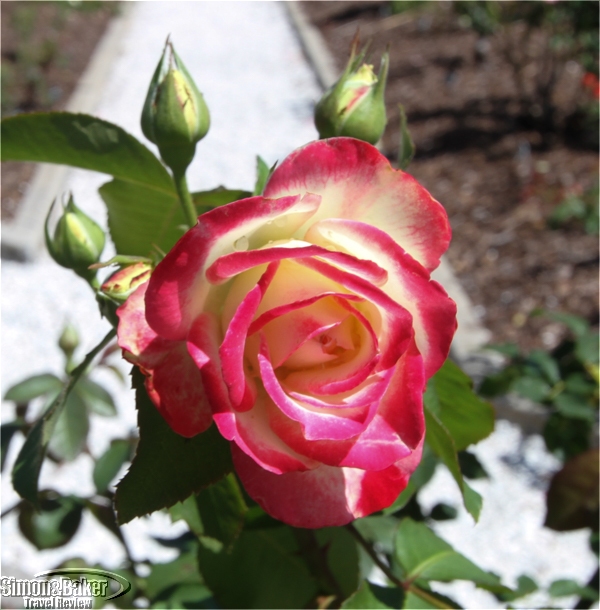
On a spring visit to the John and Mable Ringling Museum of Art in Sarasota, Florida we discovered the Mable Ringling Rose Garden (John and Mable Ringling Museum of Art, 5401 Bay Shore Road, Sarasota, Florida 34243, +1 941-359-5700 ext 2109, https://www.ringling.org/, Karen.smith@ringling.org). It was one of those sunny yet chilly and breezy days that is perfect for outdoor strolling. We saw the garden on our way to John and Mable’s storied home, now a museum, and made a point of stopping.

A signs described the history of the rose garden.
It was one of the highlights of our visit. I especially enjoyed the often fragrant flowers in 18 hues (the American Rose Society recognizes 18 colors of roses, a Ringling spokesperson explained by email), each with a name tag at the foot of the bush. The new name tags indicated if the rose was fragrant, Karen Smith, MSc., curator since 2015, Mable Ringling Rose Garden, explained when I asked about a particular flower a volunteer had suggested I see.
Flower fragrance is not a straightforward matter it turns out. It varies, according to the ratings of the American Rose Society, from Strong, Moderate and Mild, to None. So many roses were scented I was not surprised to discover 81 percent of the roses had some scent.
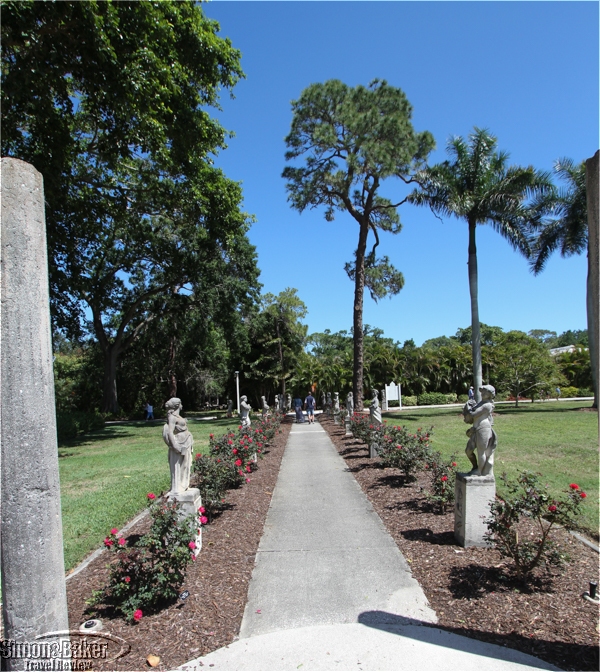
One of the paths lined with statues
At the time of our visit, excluding the miniatures and miniflora’s, 40 percent of the roses had a Strong scent, 19 percent Moderate, 22 percent Mild and 19 percent had no fragrance.
Ms. Smith is a former research scientist in the neuroscience field. Throughout thirty years in science, horticulture was always a part of her life. Care of the garden was no accident. Although she was the only employee dedicated to the garden when needed six estate gardeners were available to lend a hand. And 26 volunteers, including 15 seasonal visitors to the area, worked in the garden from three to 12 hours per month.
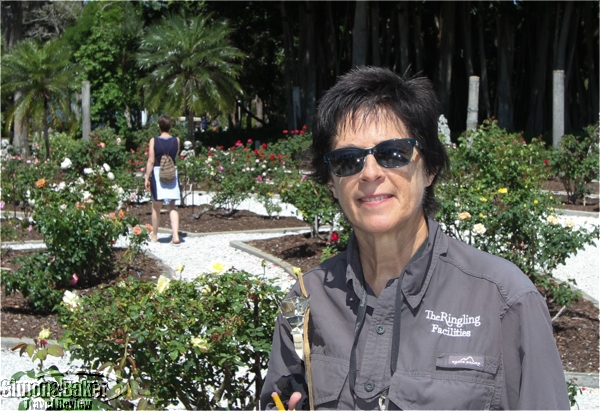
Karen Smith, MSc., curator, Mable Ringling Rose Garden
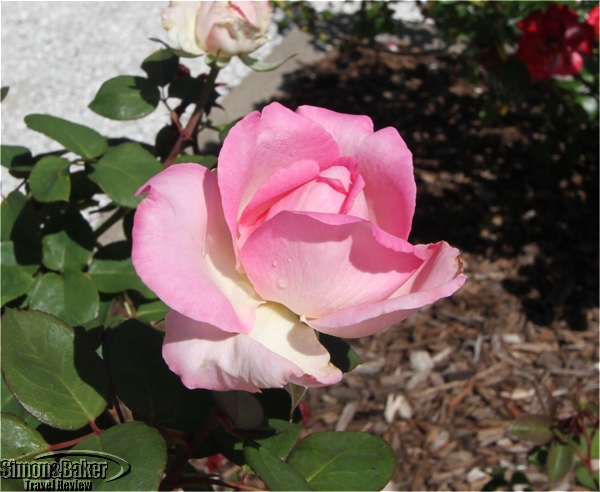
There are many challenges and stresses that can affect rose plants, the garden curator explained. She relies on Best Management Practices and a weekly monitoring system during which more than 100 bushes are inspected each week.
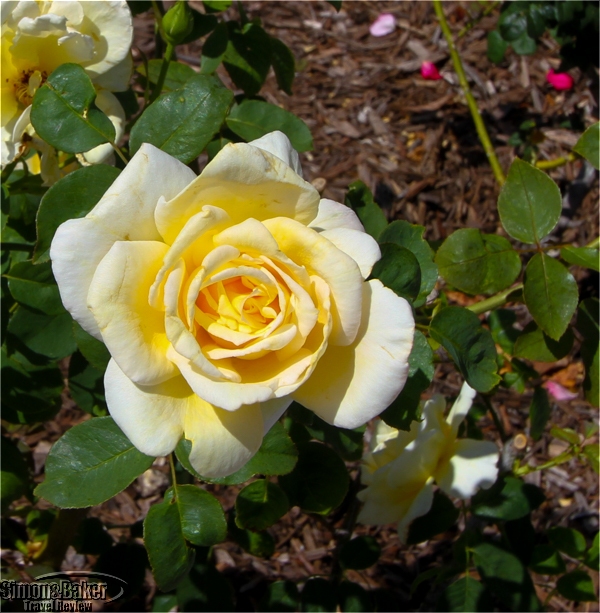
“A rating is given for pests and diseases,” she said by email. “If it is determined that the disease or pest is at a level that is unacceptable, treatment occurs. We use the safest treatment possible for each situation. For example when the weather is cool enough we will use Neem Oil as our pesticide for Aphids, Mites, Thrip, and Scale. Every spring we remove the old mulch and bring in 75 cubic yards of compost, fertilize, and re-mulch
When asked for fertilizer specifics she shared details generously, “Currently for fertilizer we use a 4-3-4 Turkey Manure (Mighty Grow) and 16-0-0 Blood meal – each four times a year. Supplement with a Sul-Po-Mag (0-0-22) twice a year. For example to fertilize once using the Mighty Grow takes 650 lbs.”
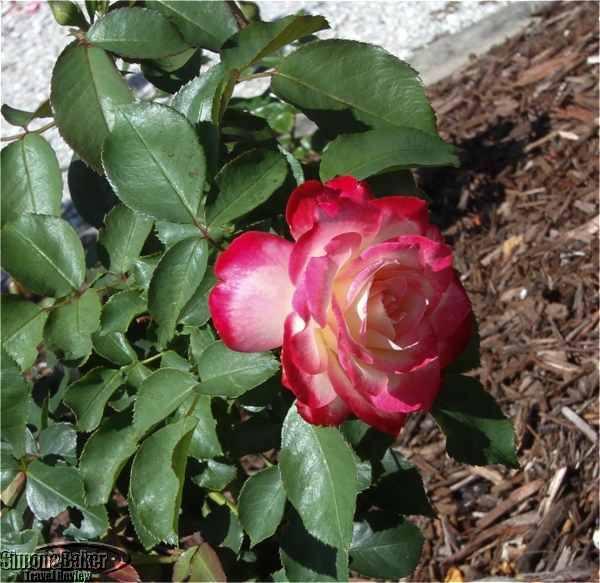
What are the best months to see the roses in bloom and at their most fragrant? December and January as well as March and April. In 2017 Hurricane Irma caused some damage to the garden so it was not at its prettiest during our visit.
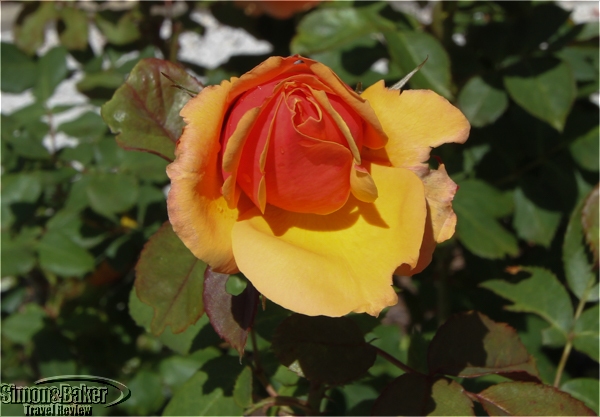
“We have two cut-backs a year, one in February and one in September, the garden curator said. “The large blooms occur approximately 8 weeks after cutback. It take us 3 weeks to complete the cutback- therefore the bloom is in phases comparable to the cutback.”
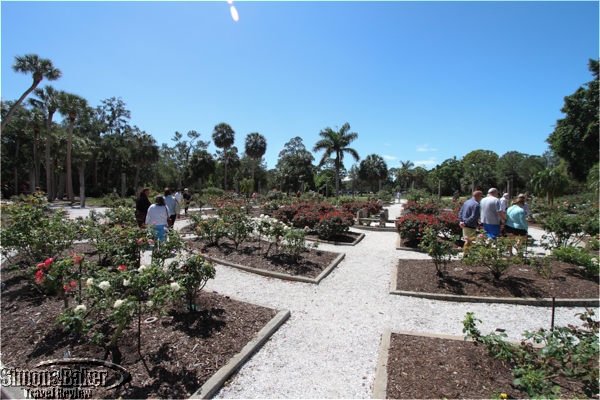
Many visitors strolled through the garden on the day of our visit.
We later discovered the garden dates back to 1913. Sadly, none of the plants from Mable’s era remain. The garden consists of 1,200 rose plants introduced between 1793 and 2002, among them Tree Roses, Hybrid Teas, Floribundas, Grandifloras, miniature roses, shrubs, Old Garden Roses (varieties introduced prior to 1867). Among them was a rose dedicated to Mable.
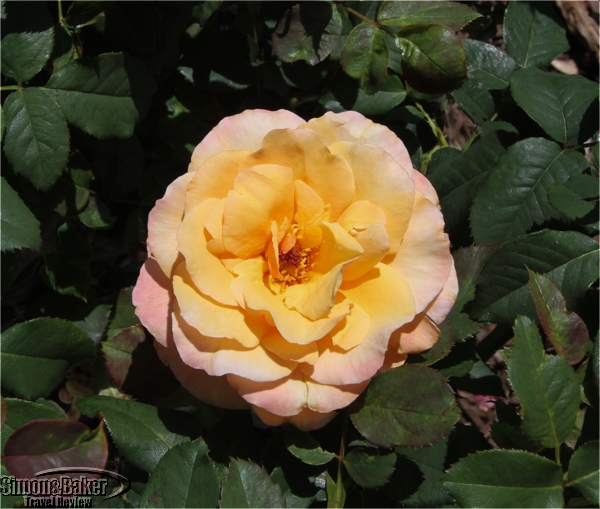
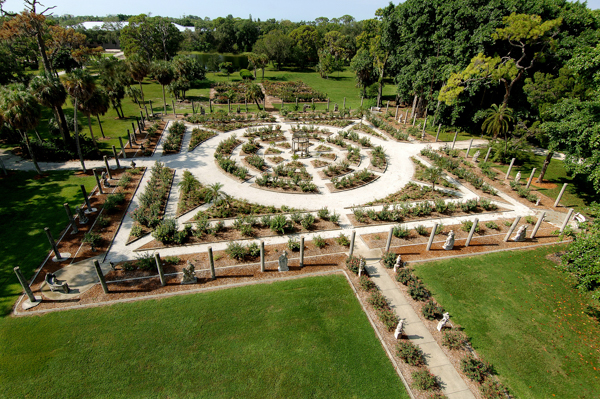
The Italian inspired Rose Garden has a circular wagon wheel design.
(Click photo to view full size)
The 27,225 square foot Italian inspired Rose Garden has a circular wagon wheel design and pathways lined with garden sculptures of courting couples in pastoral scenes. By the late 1930s the estate and the garden fell into disrepair. Many years passed before it returned to a state similar to the one we saw during our visit. By 2004 the garden was restored thanks to the efforts of the resident horticulturist, Ron Mallory and the volunteers he recruited.
It received accreditation from the All-American Rose Selections in 2004, and recognition in 2006 as the most outstanding All-American Rose Selections Public Rose Garden in the nation.
*Aerial photo of the Rose Garden (date unknown) courtesy of the John and Mable Ringling Museum of Art










 ]
]















































